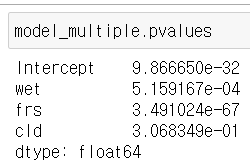Machine Learning Algorithm - linear regression (3)
Algorithms 구성
- Algorithms (1) - Machine learning basic 기초
- Algorithms (2) - Machine learning linear regression (1)
- Algorithms (2) - Machine learning linear regression (2)
- Algorithms (2) - Machine learning linear regression (3)
- Algorithms (2) - Machine learning linear regression (4)
- Algorithms (3) - Machine learning logistic regression (1)
Parameter Estimation Algorithms
Least squared estimator
- estimator: a function of the samples
- purpose of estimator: to find out unknown parameters
- types of estimator
- point estimator (점 추정)
- interval estimator (구간 추정)
point estimator
Yi = w0 + w1 Xi + εi, εi ~ N(0, σ²), i = 1, 2, … n
- w0 에 대한 point estimator: ^w0 = mean(y) - ^w1 * mean(x)
- w1 에 대한 point estimator: linear regression 2 참조
- σ²에 대한 point estimator: ^σ²= (1 / n - 2) sum ( ei²) -> residual
Interval Estimation
- 구간으로 측정하여 보다 유연한 정보 제공
- θ (parameter)에 대한 구간 측정 -> ^θ - 상수값 * std(θ) <= θ <= ^θ + 상수값 * std(θ)
기울기에 대한 가설검정
- unknown parameter에 대한 가설을 세우고 이를 검정
p-value
- p-value가 0.05나 0.01보다 작으면 reject null hypothesis
statsmodels.formula.api에 ols function을 통한 모델링을 했을때

- parameters: wet, frs, cld, intercept
- point estimates: 각각의 coef
- std: 각각의 std err


- t: 전반적으로 모든 parameters들의 abs(t)값이 > 1.96 (p < 0.05) 또는 abs(t) > 2.58 (p < 0.01) 큼 -> null hypothesis를 reject

- p-value: 모든 slope parameters이 0.05보다 큰 값이 없기 때문에 statistically significant